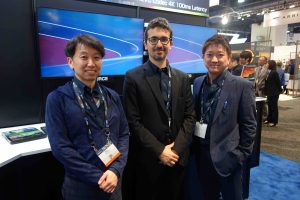NAB Reflections: NTT Electronics’ Fabi and Yoshida on the World Cup and remote production
For the first time at NAB 2018, NTT showcased a real-time 4K high frame rate HEVC codec that enables live transmission of high frame rate (HFR) video.
HFR enhances video smoothness and sharpness by doubling the frame rate of the standard video frame rate (SFR), from 50/60p to 100/120p. HFR video is especially effective for fast–moving video content such as sports. By developing this codec, NTT will contribute to enhancing the quality of broadcasts and public viewing of sporting events.
NTT is planning to proceed with trial experiments of 4K HFR services including video contribution and distribution services for broadcasters and public viewing service.

Pictured on the NTT booth at NAB: (L/R) Ryoji Suzuki, Account Manager, Overseas Digital Video Sales Department; Marco Fabi, Business Development Manager Europe; and Daisuke Yoshida, Senior Sales Manager, Overseas Digital Video Sales Department
Using an in-house ASIC, the HC11000 Series is NTT Electronics’ 4:2:2 10-bit HEVC multi-channel and 4K HDR real-time encoder. It has the capability to transmit broadcast quality video images in low bitrate, low latency with low power consumption. HC11000 has the scalable capability from SD to HD and to 4K 60p.
The HC11000 series has the necessary functions as well as the stability to be used in the Olympics, World Cup and other world class sporting events. HEVC technology can help reduce bandwidth and save operational cost while maintaining high quality. Also by using multi-channel, it will lower the price per channel.
Also on the booth was the MV7000, a new compact 1U half-rack size HEVC IP codec which provides high video quality IP/ASI transmission with low bit rate and low latency. It supports various IP related functions which enables stable and reliable live IP transmission.
At the show SVG Europe sat down with Marco Fabi, Business Development Manager, NTT Electronics Europe and Daisuke Yoshida, Senior Sales Manager, Overseas Digital Video Sales Department, NTT Electronics to catch up on the world of video codecs for live sports applications.
“In the last few months we’ve started to receive more orders for our 4K encoder/decoder for the upcoming World Cup,” said Yoshida. “[People are realising that] software encoding and decoding may not be good enough to support those large events. That’s our interpretation. In order to do the transmission in 4K, they may have realised that software encoding can’t handle their needs and decided that a hardware-based encoder/decoder is the right solution for the World Cup.
“It was challenging for us,” said Daisuke, “as we would normally have liked to get the estimate of the number of units [required] at the end of 2017, so that we could prepare and ship the units in the first quarter of 2018. Instead the orders came in during the first quarter of this year – but we made it happen.
“I think the hardware solution is the only one that can handle transportation,” said Yoshida. “Software-based uses a server-based solution, and sometimes there can be a little bit of an issue when they open the box at a location. Not always – [but what’s key is] the base quality and stability of the product itself, plus the capability to overcome rough transportation or rough logistics,” he said.
At NAB NTT Electronics also showed its Smart Contribution Solution for live remote production, which provides multiple video stream transmissions from stadiums to the broadcasting centre with a secure and managed mechanism.
“We are receiving every day many requests for remote production,” said Fabi. “It’s a very important topic now. All broadcasters and telecom companies are trying to save money, so it’s a very hot topic.
“This is a software-based system that is able to control a number of streams and this TS is sent to the destination site where the stream is opened and every steam is decoded individually,” said Fabi.
“We manage the bit rate so we are able to deal with the inefficiency of the internet connection and we’re able to adapt the bit rate automatically – always keeping a very low delay. This is for remote production, so we need to keep the delay very low,” said Fabi. “2018 is the year for remote production, I think.”
